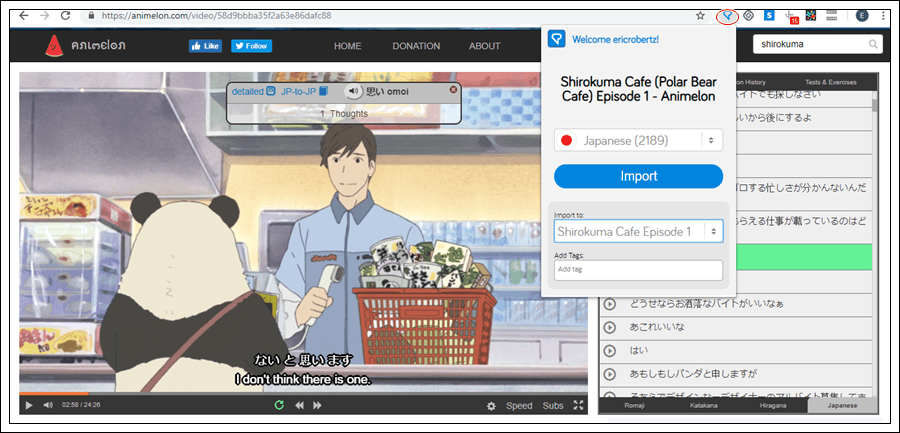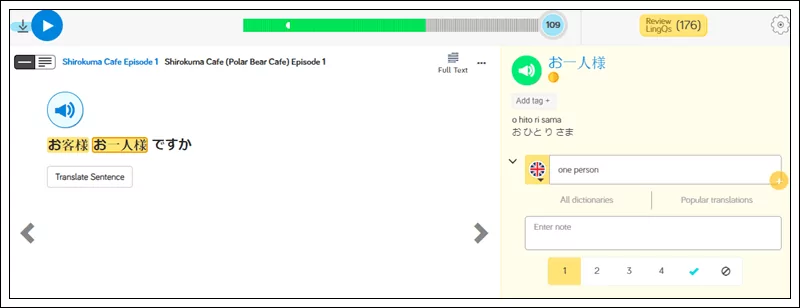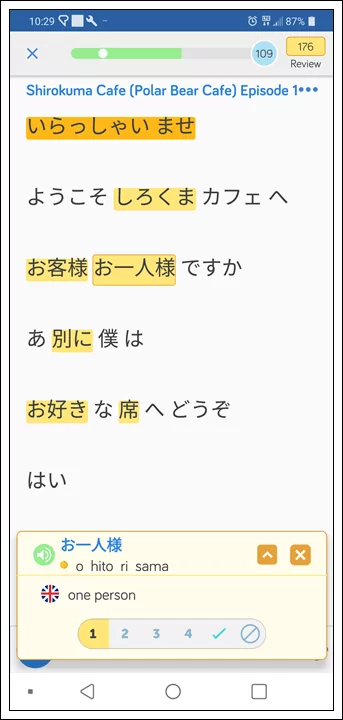Japanese Counters Explained for Beginner Learners
So you finally mastered numbers in Japanese. Great! Now you can count as easy as ichi-ni-san! But not so fast… now how do you plan on putting that new skill to use? If you thought “to count objects and express amounts more fluently,” you’ve got another thing coming. Japanese counters aren’t so straightforward.
That’s right. Unlike the English language, Japanese requires a little more work than simply plastering a number in front of an item’s name. Just like conjugations, items have their own specific counting words depending on what kind of item they are.
Sounds confusing? Don’t worry! It won’t be for long. Believe it or not, we have counters in the English language too! It’s the same concept as saying “one glass of water” (not, “one water”), or “a pair of pants” (and not, “a pant”). However in Japanese, this applies to EVERYTHING.
So instead of saying simply “one book” you would say “hon wo issatsu” (hon = book, i= one, and satsu= counter for bound objects, like books, magazines, etc). Another example would be “shashin wo ichimai” in which shashin = a photo, and mai= counter for flat objects (papers, napkins, bills, etc).
How to Know Which Japanese Counter to Use
The good news is, there is a system, so once you memorize these, it’s easy to know which word to use for which object. In most cases it’s based on the type, size, or shape of the object. For example, there are counters for flat objects such as paper, bound objects such as books, and small objects such as apples. Then there are more specific ones, such as for vehicles, time and place, people and animals, and more! We will cover the most basic ones more in depth below.
When All Else Fails?
Luckily, if you get tripped up in the beginning and forget, there is a general counting system that can work in almost all situations. (I highly recommend learning these first so you have them to fall back on when you need!) That’s the つ (tsu) system! This system is very convenient to use because you can use it in place of most specific counters, and people will still understand what you mean. (As opposed to if you confused specific counters, and used the counter for small flat objects when talking about your car!)
This system is irregular compared to the ones that follow the ichi-ni-san pattern, but once you get the hang of it you will find it handy in other counting situations as well. (Watch out for number ten! It looks like 十 (juu), which does mean ten, but in this case is pronounced “tou!”)
The General Counting System
一つ hitotsu
二つ futatsu
三つ mittsu
四つ yottsu
五つ itsutsu
六つ muttsu
七つ nanatsu
八つ hattsu
九つ kokonotsu
十 tou

Time & Dates
Time and dates are relatively straightforward, as the usage is pretty similar to English. For example, just as we would say “one second,” the Japanese equivalent is 一秒(いちびょう ichibyou) where byou counts seconds. Similarly, 分(ふん・ぷん fun/pun)is minutes, and 時(じ ji)is hours.
As for longer periods of time, such as days, weeks, and months, the counters are again used in the same way we would say “one year” or “five weeks.”
Important note: 間 (kan) is often used together with time counters to indicate periods of time. You will notice it when counting hours especially. This is because when 時 (ji) is on its own (without間), the meaning becomes “o’clock.” So, 一時 (ichiji) would mean 1 o’clock, whereas 一時間(ichijikan) would indicate 1 hour.
Here is a quick chart summing up the most common counters for time and date, up to ten.
| Seconds 秒 びょう byou |
Minute 分 ふん fun(pun) |
Hour 時間 じかん ji |
Day 日 にち nichi |
Week 週間 しゅう shuu |
Month ヶ月 かげつ kagetsu |
Year 年 ねん nen |
|
| 1 | いちびょう | いっぷん | いちじかん | いちにち | いっしゅうかん | いっかげつ | いちねん |
| 2 | にびょう | にふん | にじかん | ふつか | にしゅうかん | にっかげつ | にねん |
| 3 | さんびょう | さんぷん | さんじかん | みっか | さんしゅうかん | さんかげつ | さんねん |
| 4 | よんびょう | よんふん | よじかん | よっか | よんしゅうかん | よんかげつ | よんねん |
| 5 | ごびょう | ごふん | ごじかん | いつか | ごしゅうかん | ごかげつ | ごねん |
| 6 | ろくびょう | ろっぷん | ろくじかん | むいか | ろくしゅうかん | ろっかげつ | ろくねん |
| 7 | ななびょう | ななふん | しちじかん | なのか | ななしゅうかん | ななかげつ | ななねん |
| 8 | はちびょう | はっぷん | はちじかん | ようか | はっしゅうかん | はっかげつ | はちねん |
| 9 | きゅうびょう | きゅうふん | きゅうじかん | ここのか | きゅうしゅうかん | きゅうかげつ | きゅうねん |
| 10 | じゅうびょう | じゅっぷん | じゅうじかん | とうか | じゅっしゅうかん | じゅっかげつ | じゅうねん |

People
Next is counting people. This may sound awkward when thinking in English, but just think of it as adding the word “person” at the end of the people you are counting. Now, the symbol 人 alone may be pronounced じん・にん (jin/nin) which does mean person, however when paired with a number it becomes irregular, just like the previous “hitotsu, futatsu” counting system.
Example: 友達一人 (tomodachi hitori) – one friend
Example: 二人の学生 (futari no gakusei) two students

Places & Positions
There are also special words for counting locations, positions, order, and number of times. The conjugation is pretty similar to most other words with their unique irregularities, so we will just leave you with the meaning and the chart.
ヶ所kasho – for counting places
階 kai – floor (as in floors of a building)
回kai – number of times (doing something)
番ban – position/order (first, second, etc)
| Person 人 にん・じん nin/jin* |
Place ヶ所 っかしょ kkasho |
Floor 階 かい kai |
Time(s) 回 かい kai |
Position/ Order 番 ばん ban |
|
| 1 | 一人 ひとり |
一ヵ所 いっかしょ |
一階 いっかい |
一回 いっかい |
一番 いちばん |
| 2 | 二人 ふたり |
二ヵ所 にかしょ |
二階 にかい |
二回 にかい |
二番 にばん |
| 3 | 三人 さんにん |
三ヵ所 さんかしょ |
三階 さんかい |
三回 さんかい |
三番 さんばん |
| 4 | 四人 よんにん |
四ヵ所 よんかしょ |
四階 よんかい |
四回 よんかい |
四番 よんばん |
| 5 | 五人 ごにん |
五ヵ所 ごかしょ |
五階 ごかい |
五回 ごかい |
五番 ごばん |
| 6 | 六人 ろくにん |
六ヶ所 ろっかしょ |
六階 ろっかい |
六回 ろっかい |
六番 ろくばん |
| 7 | 七人 しちにん |
七ヵ所 ななかしょ |
七階 ななかい |
七回 ななかい |
七番 ななばん |
| 8 | 八人 はちにん |
八ヶ所 はっかしょ |
八階 はっかい |
八回 はっかい |
八番 はちばん |
| 9 | 九人 | 九ヵ所 きゅうかしょ |
九階 きゅうかい |
九回 きゅうかい |
九番 きゅうばん |
| 10 | 十人 じゅうにん |
十ヵ所 じゅうかしょ |
十階 じゅっかい |
十回 じゅっかい |
十番 じゅうばん |

Size and Shapes
The next group is for counters that are determined by size and shape of an object. Note that within these there may be certain items with even more specific counters (for example, you might think a slice of cheese fits in with 枚mai, the counter for flat objects, but it actually has its own counter, 切れkire, and is actually closer to the English word “a slice”).
枚mai – for flat objects (paper, bills, napkins, photos, cloth, door, wall, plate, mat, etc)
冊satsu – for bound objects (books, magazines, newspapers, notebooks)
本 hon/pon – for long, cylindrical objects (pencils, straws, bottles, chopsticks, umbrellas, cigarettes, etc.)
匹 hiki/ppiki – small animals (dog, cat, mouse, squirrels, some insects, etc.)
個ko – small (usually round, but not always) objects (fruit, rocks, small accessories, small toys,
台dai – large objects such as vehicles and machines (bikes, cars, boats, computers, appliances)
| Flat objects 枚 まい mai |
Bound objects 冊 さつ satsu |
Long cylindrical本 ほん hon |
Small animals 匹 ひき hiki |
Small objects 個 こ ko |
Vehicles, Machines台 だい dai |
|
| 1 | 一枚 いちまい |
一冊 いっさつ |
一本 いっぽん |
一匹 いっぴき |
一個 いっこ |
一台 いちだい |
| 2 | 二枚 にまい |
二冊 にさつ |
二本 にほん |
二匹 にひき |
二個 にこ |
二台 にだい |
| 3 | 三枚 さんまい |
3冊 さんさつ |
三本 さんぼん |
三匹 さんびき |
三個 さんこ |
三台 さんだい |
| 4 | 四枚 よんまい |
四冊 よんさつ |
四本 よんほん |
四匹 よんひき |
四個 よんこ |
四台 よんだい |
| 5 | 五枚 ごまい |
五冊 ごさつ |
五本 ごほん |
五匹 ごひき |
五個 ごこ |
五台 ごだい |
| 6 | 六枚 ろくまい |
六冊 ろくさつ |
六本 ろっぽん |
六匹 ろっぴき |
六個 ろっこ |
六台 ろくだい |
| 7 | 七枚 ななまい |
七冊 ななさつ |
七本 ななほん |
七匹 ななひき |
七個 ななこ |
七大 ななだい |
| 8 | 八枚 はちまい |
八冊 はちさつ |
八本 はっぽん |
八匹 はっぴき |
八個 はっこ |
八台 はちだい |
| 9 | 九枚 きゅうまい |
九冊 きゅうさつ |
九本 きゅうほん |
九匹 きゅうひき |
九個 きゅうこ |
九台 きゅうだい |
| 10 | 十枚 じゅうまい |
十冊 じゅうさつ |
十本 じゅっぽん |
十匹 じゅっぴき |
十個 じゅっこ |
十台 じゅうだい |
Bonus Japanese Counters
Just to make things a little more interesting, here are some very specific Japanese counters you can cram into your brain if you have any room left.
脚 kyaku – for chairs with legs
個 ko – for chairs without legs
話 wa – for episodes (of your favorite show!)
串 kushi – for skewers and kebabs
門 mon – for cannons
How to Learn Japanese Counters
There we have some of the most common counters you will probably be seeing as you study Japanese more and more.
Rather than memorize this post section by section, a more enjoyable way to learn Japanese counters is by finding them splashed around your favorite stories, anime, or songs. I mean, wouldn’t you want to see how Japanese counters are used in different context?
The best way to come across Japanese counters is by using LingQ. LingQ is the best way to learn Japanese online because it lets you learn from content you enjoy! Not only is there 1000s of hours of content to read and listen to, but you can import content too.
Let me quickly show you how to import by using one of my favorite anime shows, Shirokuma Cafe.
Install the LingQ browser extension (a simple Google search will help you find it), head over to Animelon, and search “Shirokuma Cafe”.
Open an episode, click the LingQ extension, and hit the import button.

Once it’s imported, go to LingQ and you’ll have your brand new lesson that includes the Japanese transcript and audio from the episode you’ve imported!

Also, LingQ’s mobile app lets you access your lessons on your phone. Put your headphones on and take advantage of those long commutes to work 😉

For more information on how to import your favorite anime, please check out this post.
Good luck!
***
Krystle is a NYC native who has spent more than half of her life studying Japanese language and culture. A former English teacher in Japan, she now uses her skills as a translator, and to help new learners of both languages.


